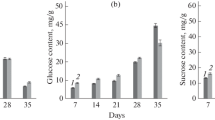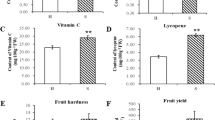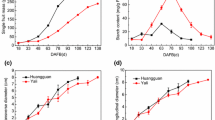Abstract
The accumulation of soluble sugars in fleshy fruits largely determines their sweetness or taste. A spontaneous sweet orange mutant ‘Hong Anliu’ (HAL, Citrus sinensis) accumulates low soluble sugar content in fruit juice sacs than its wild type, ‘Anliu’ (AL) orange; however, the cause of reduced sugar content in ‘HAL’ fruit remains unclear. In this study, sugar content and expression profiles of genes involved in sugar metabolism and transport were compared between ‘HAL’ and ‘AL’ fruit juice sacs. In both cultivars, fructose and glucose displayed the increasing trends with significantly lower contents in ‘HAL’ than ‘AL’ after 160 DAF; moreover, sucrose had a declining trend in ‘HAL’ and increasing trend in ‘AL’ with fruit development. On the other hand, transcript levels of VINV, CWINV1, CWINV2, SUS4, SUS5, SPS1, SPS2, VPP-1, VPP-2, and some sugar transporter genes were significantly decreased in ‘HAL’ compared with ‘AL’ after 100 DAF or 160 DAF. Interestingly, the transcript levels of SPS2 and SUT2 exhibited a similar trend as it was found for sucrose content in both cultivars. These results suggested that the low sugar accumulation in ‘HAL’ fruit JS is accompanied by the reduced sink strength, sucrose-synthesis ability, and vacuolar storage ability compared with ‘AL’; reduction of CWINVs, VINV, SPS2, SUT2, VPP-1, and VPP-2 transcript levels possibly plays a key role in the low storage of soluble sugars in the vacuoles of mutant juice sacs.







Similar content being viewed by others
References
Tietel Z, Plotto A, Fallik E, Lewinsohn E, Porat R (2011) Taste and aroma of fresh and stored mandarins. J Sci Food Agric 91(1):14–23
Lado J, Gambetta G, Zacarias L (2018) Key determinants of citrus fruit quality: metabolites and main changes during maturation. Sci Hortic 233:238–248. https://doi.org/10.1016/j.scienta.2018.01.055
Ruan YL (2014) Sucrose metabolism: gateway to diverse carbon use and sugar signaling. Annu Rev Plant Biol 65:33–67. https://doi.org/10.1146/annurev-arplant-050213-040251
Sadka A, Shlizerman L, Kamara I, Blumwald E (2019) Primary metabolism in citrus fruit as affected by its unique structure. Front Plant Sci. https://doi.org/10.3389/fpls.2019.01167
Zhang C, Turgeon R (2018) Mechanisms of phloem loading. Curr Opin Plant Biol 43:71–75. https://doi.org/10.1016/j.pbi.2018.01.009
Hiratsuka S, Nakayama S, Tamura S, Nada K (2017) Translocation and accumulation of fruit-fixed photosynthate in Satsuma mandarin. Plant Growth Regul 81(2):277–282. https://doi.org/10.1007/s10725-016-0204-9
Hedrich R, Sauer N, Neuhaus HE (2015) Sugar transport across the plant vacuolar membrane: nature and regulation of carrier proteins. Curr Opin Plant Biol 25:63–70. https://doi.org/10.1016/j.pbi.2015.04.008
Liu Y, Heying E, Tanumihardjo SA (2012) History, global distribution, and nutritional importance of citrus fruits. Compr Rev Food Sci Food Saf 11(6):530–545. https://doi.org/10.1111/j.1541-4337.2012.00201.x
Asencio AD, Serrano M, García-Martínez S, Pretel MT (2018) Organic acids, sugars, antioxidant activity, sensorial and other fruit characteristics of nine traditional Spanish Citrus fruits. Eur Food Res Technol 244(8):1497–1508. https://doi.org/10.1007/s00217-018-3064-x
Goldenberg L, Yaniv Y, Porat R, Carmi N (2018) Mandarin fruit quality: a review. J Sci Food Agric 98(1):18–26. https://doi.org/10.1002/jsfa.8495
Opara LU, Al-Said FA, Al-Abri A (2007) Assessment of what the consumer values in fresh fruit quality: case study of Oman. N Z J Crop Hortic Sci 35(2):235–243
Goldschmidt E, Koch K (1996) Citrus. In: Zamski E, Schaffer A (eds) Photoassimilate distribution in plants and crops: source-sink relationships, 1st edn. Tailor and Francis Group, New York, pp 797–823
Lowell CA, Tomlinson PT, Koch KE (1989) Sucrose-metabolizing enzymes in transport tissues and adjacent sink structures in developing citrus fruit. Plant Physiol 90(4):1394–1402. https://doi.org/10.1104/pp.90.4.1394
Komatsu A, Moriguchi T, Koyama K, Omura M, Akihama T (2002) Analysis of sucrose synthase genes in citrus suggests different roles and phylogenetic relationships. J Exp Bot 53(366):61–71
Komatsu A, Takanokura Y, Moriguchi T, Omura M, Akihama T (1999) Differential expression of three sucrose-phosphate synthase isoforms during sucrose accumulation in citrus fruits (Citrus unshiu Marc.). Plant Sci 140(2):169–178. https://doi.org/10.1016/S0168-9452(98)00217-9
Kubo T, Hohjo I, Hiratsuka S (2001) Sucrose accumulation and its related enzyme activities in the juice sacs of satsuma mandarin fruit from trees with different crop loads. Sci Hortic 91(3–4):215–225
Zheng Q-M, Tang Z, Xu Q, Deng X-X (2014) Isolation, phylogenetic relationship and expression profiling of sugar transporter genes in sweet orange (Citrus sinensis). Plant Cell Tissue Organ Cult 119(3):609–624. https://doi.org/10.1007/s11240-014-0560-y
Islam MZ, Jin L-F, Shi C-Y, Liu Y-Z, Peng S-A (2015) Citrus sucrose transporter genes: genome-wide identification and transcript analysis in ripening and ABA-injected fruits. Tree Genet Genomes 11(5):97. https://doi.org/10.1007/s11295-015-0918-2
Yao Li C, Shi JX, Weiss D, Goldschmidt EE (2003) Sugars regulate sucrose transporter gene expression in citrus. Biochem Biophys Res Commun 306(2):402–407. https://doi.org/10.1016/S0006-291X(03)00978-1
Liu Q, Xu J, Liu YZ, Zhao XL, Deng XX, Guo LL, Gu JQ (2007) A novel bud mutation that confers abnormal patterns of lycopene accumulation in sweet orange fruit (Citrus sinensis L. Osbeck). J Exp Bot 58(15–16):4161–4171. https://doi.org/10.1093/jxb/erm273
Pan Z, Li Y, Deng X, Xiao S (2014) Non-targeted metabolomic analysis of orange (Citrus sinensis [L.] Osbeck) wild type and bud mutant fruits by direct analysis in real-time and HPLC-electrospray mass spectrometry. Metabolomics 10(3):508–523. https://doi.org/10.1007/s11306-013-0597-7
Guo LX, Shi CY, Liu X, Ning DY, Jing LF, Yang H, Liu YZ (2016) Citrate accumulation-related gene expression and/or enzyme activity analysis combined with metabolomics provide a novel insight for an orange mutant. Sci Rep 6:29343. https://doi.org/10.1038/srep29343
Xu Q, Yu KQ, Zhu AD, Ye JL, Liu Q, Zhang JC, Deng XX (2009) Comparative transcripts profiling reveals new insight into molecular processes regulating lycopene accumulation in a sweet orange (Citrus sinensis) red-flesh mutant. BMC Genom 10:540
Shi C-Y, Hussain SB, Yang H, Bai Y-X, Khan MA, Liu Y-Z (2019) CsPH8, a P-type proton pump gene, plays a key role in the diversity of citric acid accumulation in citrus fruits. Plant Sci 289:110288. https://doi.org/10.1016/j.plantsci.2019.110288
Bartolozzi F, Bertazza G, Bassi D, Cristoferi G (1997) Simultaneous determination of soluble sugars and organic acids as their trimethylsilyl derivatives in apricot fruits by gas-liquid chromatography. J Chromatogr A 758(1):99–107
Liu YZ, Liu Q, Tao NG, Deng XX (2006) Efficient isolation of RNA from fruit peel and pulp of ripening navel orange (Citrus sinensis Osbeck). J HZAU 25(3):300–304
Livak KJ, Schmittgen TD (2001) Analysis of relative gene expression data using real-time quantitative PCR and the 2 [-Delta Delta C(T)] method. Methods 25:402–408
Liao H-L, Burns JK (2012) Gene expression in Citrus sinensis fruit tissues harvested from huanglongbing-infected trees: comparison with girdled fruit. J Exp Bot 63(8):3307–3319. https://doi.org/10.1093/jxb/ers070
Dahro B, Wang F, Peng T, Liu J-H (2016) PtrA/NINV, an Alkaline/neutral invertase gene of Poncirus trifoliata, confers enhanced tolerance to multiple abiotic stresses by modulating ROS levels and maintaining photosynthetic efficiency. BMC Plant Biol. https://doi.org/10.1186/s12870-016-0761-0
Islam MZ, Hu X-M, Jin L-F, Liu Y-Z, Peng S-A (2014) Genome-wide identification and expression profile analysis of citrus sucrose synthase genes: investigation of possible roles in the regulation of sugar accumulation. PLoS ONE 9(11):e113623. https://doi.org/10.1371/journal.pone.0113623
Segami S, Asaoka M, Kinoshita S, Fukuda M, Nakanishi Y, Maeshima M (2018) Biochemical, structural and physiological characteristics of vacuolar H+-pyrophosphatase. Plant Cell Physiol 59(7):1300–1308. https://doi.org/10.1093/pcp/pcy054
Maldonado-Celis ME, Yahia EM, Bedoya R, Landazuri P, Loango N, Aguillon J, Restrepo B, Guerrero Ospina JC (2019) Chemical composition of mango (Mangifera indica L.) fruit: nutritional and phytochemical compounds. Front Plant Sci 10:1073. https://doi.org/10.3389/fpls.2019.01073
Yang Z, Wang T, Wang H, Huang X, Qin Y, Hu G (2013) Patterns of enzyme activities and gene expressions in sucrose metabolism in relation to sugar accumulation and composition in the aril of Litchi chinensis Sonn. J Plant Physiol 170(8):731–740. https://doi.org/10.1016/j.jplph.2012.12.021
Vimolmangkang S, Zheng H, Peng Q, Jiang Q, Wang H, Fang T, Liao L, Wang L, He H, Han Y (2016) Assessment of sugar components and genes involved in the regulation of sucrose accumulation in peach fruit. J Agric Food Chem 64(35):6723–6729. https://doi.org/10.1021/acs.jafc.6b02159
Ladaniya MS (2008) Fruit biochemistry. Citrus fruit: biology, technology and evaluation, 1st edn. Academic Press, New York, pp 127–134
Albertini M-V, Carcouet E, Pailly O, Gambotti C, Luro F, Berti L (2006) Changes in organic acids and sugars during early stages of development of acidic and acidless citrus fruit. J Agric Food Chem 54(21):8335–8339. https://doi.org/10.1021/jf061648j
Tadeo J, Ortiz J, Estelles A (1987) Sugar changes in clementine and orange fruit during ripening. J Horticult Sci 62(4):531–537
Kafkas E, Polatöz S, Koç N (2011) Quantification and comparison of sugars, carboxylic acids and vitamin c components of various citrus species by HPLC techniques. J Agric Sci Technol 5 (2)
Bermejo A, Cano A (2012) Analysis of nutritional constituents in twenty citrus cultivars from the mediterranean area at different stages of ripening. Food Nutr Sci 3(5):12. https://doi.org/10.4236/fns.2012.35088
Jiang N, Jin L-F, Teixeira da Silva JA, Islam MDZ, Gao H-W, Liu Y-Z, Peng S-A (2014) Activities of enzymes directly related with sucrose and citric acid metabolism in citrus fruit in response to soil plastic film mulch. Sci Hortic 168:73–80
Wang JH, Liu JJ, Chen KL, Li HW, He J, Guan B, He L (2017) Comparative transcriptome and proteome profiling of two Citrus sinensis cultivars during fruit development and ripening. BMC Genom 18(1):984
Shiratake K, Martinoia E (2007) Transporters in fruit vacuoles. Plant Biotechnol 24(1):127–133. https://doi.org/10.5511/plantbiotechnology.24.127
Echeverria E, Valich J (1988) Carbohydrate and enzyme distribution in protoplasts from valencia orange juice sacs. Phytochemistry 27(1):73–76. https://doi.org/10.1016/0031-9422(88)80593-4
Etienne C, Dirlewanger E, Cosson P, Svanella-Dumas L, Monet R, Moing A, Rothan C, Bodénès C, Plomion C, Kervella J (2002) QTLs and genes controlling Peach fruit quality. Acta Hortic 592:253–258. https://doi.org/10.17660/ActaHortic.2002.592.35
Ferjani A, Segami S, Horiguchi G, Muto Y, Maeshima M, Tsukaya H (2011) Keep an eye on PPi: the vacuolar-type H+-pyrophosphatase regulates postgerminative development in Arabidopsis. Plant Cell 23(8):2895–2908. https://doi.org/10.1105/tpc.111.085415
Asaoka MM, Segami S, Ferjani A, Maeshima M (2016) Contribution of PPi-hydrolyzing function of vacuolar H(+)-pyrophosphatase in vegetative growth of Arabidopsis: evidenced by expression of uncoupling mutated enzymes. Front Plant Sci 7:415. https://doi.org/10.3389/fpls.2016.00415
Acknowledgements
The authors would like to thank Dr. Linlin Zhong for technical support with gas–liquid chromatography.
Funding
This work was supported by the National Key R & D Program of China (2019YFD1000101) and the earmarked fund for China Agriculture Research System (CARS-26).
Author information
Authors and Affiliations
Corresponding author
Ethics declarations
Conflict of interest
The authors have declared no conflicts of interest.
Ethical approval
This article does not contain any studies with human participants or animals performed by any of the authors.
Additional information
Publisher's Note
Springer Nature remains neutral with regard to jurisdictional claims in published maps and institutional affiliations.
Electronic supplementary material
Below is the link to the electronic supplementary material.
Rights and permissions
About this article
Cite this article
Hussain, S.B., Guo, LX., Shi, CY. et al. Assessment of sugar and sugar accumulation-related gene expression profiles reveal new insight into the formation of low sugar accumulation trait in a sweet orange (Citrus sinensis) bud mutant. Mol Biol Rep 47, 2781–2791 (2020). https://doi.org/10.1007/s11033-020-05387-6
Received:
Accepted:
Published:
Issue Date:
DOI: https://doi.org/10.1007/s11033-020-05387-6




